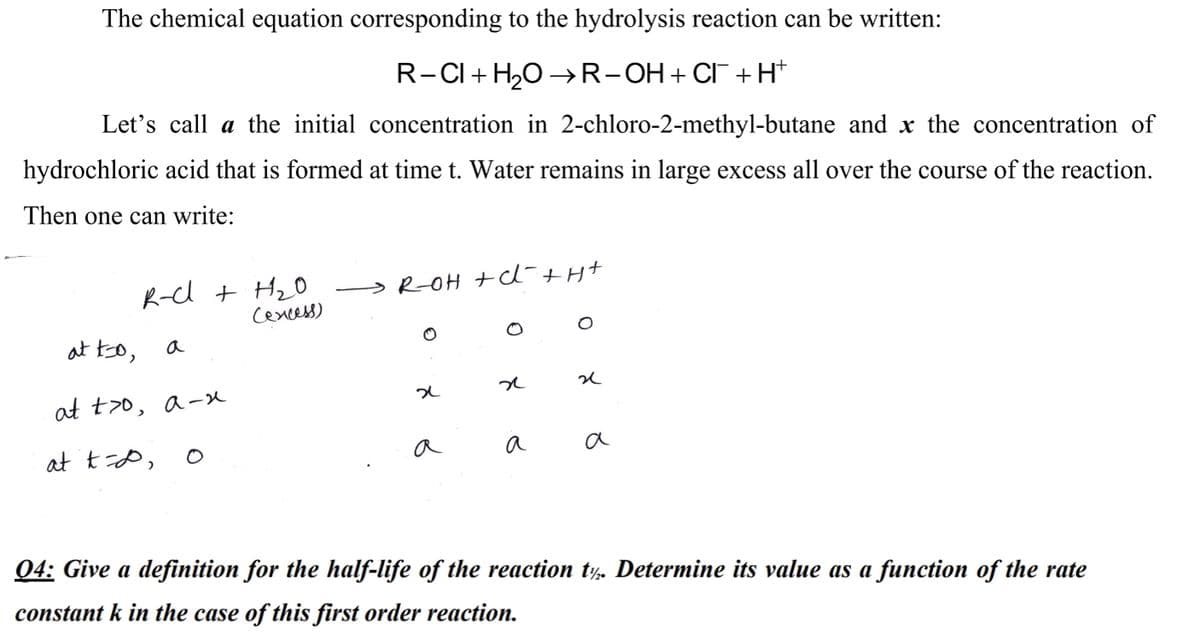The chemical equation corresponding to the hydrolysis reaction can be written: R-CI+ H,0 → R-OH+ CI +H* Let's call a the initial concentration in 2-chloro-2-methyl-butane and x the concentration of hydrochloric acid that is formed at time t. Water remains in large excess all over the course of the reaction. Then one can write: K-d + H20 Cexcess) > R-OH td-+ht at to, a at t7o, a-x at tP, a a a 04: Give a definition for the half-life of the reaction t. Determine its value as a function of the rate constant k in the case of this first order reaction.
The chemical equation corresponding to the hydrolysis reaction can be written: R-CI+ H,0 → R-OH+ CI +H* Let's call a the initial concentration in 2-chloro-2-methyl-butane and x the concentration of hydrochloric acid that is formed at time t. Water remains in large excess all over the course of the reaction. Then one can write: K-d + H20 Cexcess) > R-OH td-+ht at to, a at t7o, a-x at tP, a a a 04: Give a definition for the half-life of the reaction t. Determine its value as a function of the rate constant k in the case of this first order reaction.
Chemistry: The Molecular Science
5th Edition
ISBN:9781285199047
Author:John W. Moore, Conrad L. Stanitski
Publisher:John W. Moore, Conrad L. Stanitski
Chapter11: Chemical Kinetics: Rates Of Reactions
Section: Chapter Questions
Problem 113QRT
Related questions
Question

Transcribed Image Text:The chemical equation corresponding to the hydrolysis reaction can be written:
R-CI+ H2O →R-OH+CI¯+ H*
Let's call a the initial concentration in 2-chloro-2-methyl-butane and x the concentration of
hydrochloric acid that is formed at time t. Water remains in large excess all over the course of the reaction.
Then one can write:
R-l + H20
Cexcess)
> R-OH +d-+ht
at to,
a
at t>0, a-se
at tD,
a
a
a
04: Give a definition for the half-life of the reaction t¼. Determine its value as a function of the rate
constant k in the case of this first order reaction.
Expert Solution
This question has been solved!
Explore an expertly crafted, step-by-step solution for a thorough understanding of key concepts.
Step by step
Solved in 2 steps with 2 images

Knowledge Booster
Learn more about
Need a deep-dive on the concept behind this application? Look no further. Learn more about this topic, chemistry and related others by exploring similar questions and additional content below.Recommended textbooks for you

Chemistry: The Molecular Science
Chemistry
ISBN:
9781285199047
Author:
John W. Moore, Conrad L. Stanitski
Publisher:
Cengage Learning

Chemistry & Chemical Reactivity
Chemistry
ISBN:
9781337399074
Author:
John C. Kotz, Paul M. Treichel, John Townsend, David Treichel
Publisher:
Cengage Learning

Physical Chemistry
Chemistry
ISBN:
9781133958437
Author:
Ball, David W. (david Warren), BAER, Tomas
Publisher:
Wadsworth Cengage Learning,

Chemistry: The Molecular Science
Chemistry
ISBN:
9781285199047
Author:
John W. Moore, Conrad L. Stanitski
Publisher:
Cengage Learning

Chemistry & Chemical Reactivity
Chemistry
ISBN:
9781337399074
Author:
John C. Kotz, Paul M. Treichel, John Townsend, David Treichel
Publisher:
Cengage Learning

Physical Chemistry
Chemistry
ISBN:
9781133958437
Author:
Ball, David W. (david Warren), BAER, Tomas
Publisher:
Wadsworth Cengage Learning,

Chemistry
Chemistry
ISBN:
9781305957404
Author:
Steven S. Zumdahl, Susan A. Zumdahl, Donald J. DeCoste
Publisher:
Cengage Learning

Chemistry: Matter and Change
Chemistry
ISBN:
9780078746376
Author:
Dinah Zike, Laurel Dingrando, Nicholas Hainen, Cheryl Wistrom
Publisher:
Glencoe/McGraw-Hill School Pub Co